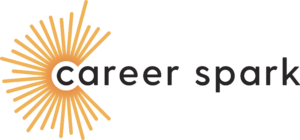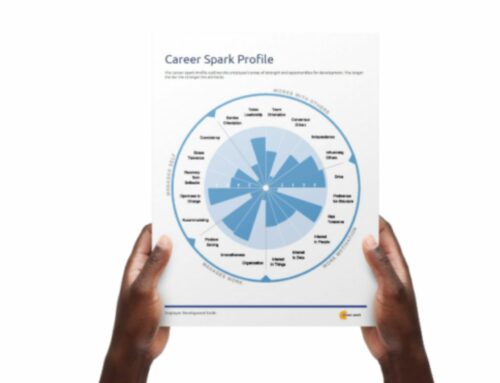Innovating in HR – Career Spark

If HR wants a consistent seat at the table of critical organizational decisions, it needs to realize that it is overseeing the most critical asset and largest line item in any business: its people.
But when it comes to HR technology, most new systems and software are designed to support HR processes. For example, applicant tracking software helps recruiters save time and stay organized as they search for the best candidates and electronic signature software can help speed up the onboarding process by eliminating the need for printing and scanning physical documents.
Now don’t get us wrong – all of these tools do serve an important function and help make HR professionals’ lives easier, but they don’t directly impact outcomes. Take an ATS, for instance. It may help you spend less time on admin tasks or screen candidates faster, but it doesn’t help solve more serious problems like employee disengagement or high turnover.
If you find you keep missing the mark with people decisions like hiring or promotions, doing them more often or faster doesn’t solve the problem. You’re just pouring water into a leaky bucket. What you need to do is start thinking beyond process and consider how HR can actually impact business outcomes.
Thinking Beyond Process
True innovation in HR isn’t about the latest and greatest technology. It’s a mindset shift. A transition from following to leading, process to outcomes, and budget to ROI. And this all starts with asking different questions.
When faced with new options and strategies, the first thing many people consider is the price. The next thing usually considered is the cost of alternatives: what else could be implemented for the cost of this solution?
However, the missing piece in many peoples’ decision making process is the opportunity cost or the cost of not doing something. The cost of not hiring the right people. The cost of not investing in the right technology. The cost of not implementing a new employee engagement initiative or addressing culture issues.
Often, the cost of not doing something has much larger implications on an organization’s success but, because it’s the status quo, it’s not seen as a cost and this is a huge mistake. Your staff are your biggest expense. They also have the potential to make the most significant impact on your organization. So rather than investing in tools to simply manage that staff more easily, why not look for solutions that help you be much smarter with the decisions that are made regarding people?
The Future of HR
Ultimately, this all comes down to ROI. Before you look at the price of a technology solution and say you can’t afford it, make sure you’re considering all the costs of not addressing the problem at hand. Take employee engagement, for instance. If a disengaged employee leaves your organization, there are quantifiable costs, roughly $30,000 in losses.
There are also qualitative costs that are much harder to track. “Disengagement is contagious – poor performers lower the bar for other workers on their teams, and their bad habits spread throughout the organization,” said Rosemary Haefner, CHRO at CareerBuilder.
Low morale, lost productivity, decreased teamwork and collaboration, and a potential hit to your company’s reputation if a client has a bad experience are just a few of the qualitative costs to employee disengagement. You also lose everything that person knows – their skills, experiences, and organizational knowledge.
These are some of the real, hard costs to issues like employee disengagement and high turnover. HR could play a more strategic role within the organization and help solve these problems, but they’re too often focused on more administrative work like managing employee records, distributing and tracking company policies and procedures, and onboarding new hires.
Great HR teams and HR leaders think strategically and look for ways to drive business success. When HR plays a strategic role in the business, it adds value to the bottom line in three key ways.
- Finding the best talent: Inefficient processes can cost you qualified hires, but HR can play a more strategic role by investing in predictive people intelligence software to clearly define the skills, behaviors, and experiences that lead to success in a particular role. They can also help promote internal mobility to ensure you have the right people in the right seats.
- Keeping employees engaged: Employee engagement is more than team socials and workplace shoutouts. Research by MIT shows that organizations with the highest employee experience achieve twice the innovation, double the customer satisfaction and 25% higher profits than organizations in the bottom quartile. As a strategic partner, HR can be the architect of your company’s employee experience by acquiring the right tools to diagnose employee disengagement and coming up with tailored solutions to help your people do their best work.
- Increased employee value: Employee retention doesn’t just save you turnover costs. The longer an employee stays with you, the more valuable they become. They get better and more efficient at their jobs, they learn more about your company, and they build deeper relationships within the company, which can all positively affect the customer experience and the productivity of your company as a whole.
Final Thoughts
Finding innovative HR solutions is about more than the price tag. Every time someone turns over, whether they’re a good or bad fit, there are very real costs that processes alone can’t fix. Fortunately, there is a way for HR to address these core issues and it starts with getting the right data to make better decisions.
The more you know about what your employees need to be successful, and what a successful career looks like for your employees, the closer you’ll get to matching the right people with the right roles. And lucky for you, Career Spark has developed an employee-facing, career pathing and development solution that can help you do just that. Instead of asking how they can hire or fire faster, HR needs to ask themselves how they can impact the bottom line and let people, not processes, take center stage.













